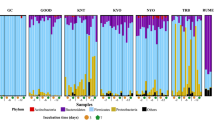Abstract
The quantitation and characterization of indigenous bacteria of a deep aquifer, located in the southwestern United States and contaminated with halogenated aliphatic compounds, was undertaken. Water samples were obtained aseptically from depths of 45 to 151 m from four sites that ranged from 260 to 1,800 m in distance from the location of contaminant release. Sediment samples were also obtained from the proximal and distal sites for analyses. Results for aerobic and anaerobic colony-forming units were obtained on four agar media that were used to retrieve heterotrophs, oligotrophs, and pseudomonads. Most probable number estimates were obtained from a liquid medium favorable for oligotrophs. Representative isolates were tested against Biolog plates (Biolog, Inc., Hayward, Calif.) for patterns of carbon source utilization. Of 103 Gram-negative (GN) isolates, 48 could not be identified and the others were only tentatively identified via the Biolog database, and none of the 35 Gram-positive (GP) isolates were identifiable. However, the metabolic patterns were subjected to average cluster linkage analyses; the GN and GP bacteria were separable into eight and four groups, respectively. The oligotroph group comprised one-third of the GN and one-half of the GP isolates. The consensus carbon source utilization pattern for each group was determined and will be useful in future characterization of additional aquifer bacterial isolates. Although predominantly aerobic and oligotrophic, the microbial community of this aquifer was highly diverse with discernible viability and metabolic features of the microbiota distinctive to each of the four water and two sediment samples.
Similar content being viewed by others
References
Balkwill DL (1989) Numbers, diversity, and morphological characteristics of aerobic, chemoheterotrophic bacteria in deep subsurface sediments from a site in South Carolina. Geomicrobiol J 7:33–52
Balkwill DL (1990) Deep-aquifer microrganisms. In: Labeda DP (ed) Isolation of biotechnological organisms from nature. McGraw-Hill, New York, pp 183–211
Baron EJ, Finegold SM (1990) Bailey and Scott's diagnostic microbiology, 8th ed. CV Mosby Company, St. Louis, pp 104–106
Fredrickson JK, Garland TR, Hicks RJ, Thomas JM, Li SW, McFadden KM (1989) Lithotrophic and heterotrophic bacteria in deep subsurface sediments and their relation to sediment properties. Geomicrobiol J 7:53–66
Fredrickson JK, Balkwill DL, Zachara JM, Li SMW, Brockman FJ, Simmons MA (1991) Physiological diversity and distributions of heterotrophic bacteria in deep cretaceous sediments of the Atlantic Coastal plain. Appl Environ Microbiol 57:402–411
Fry JC (1990) Oligotrophs. In: Edwards C (ed) Microbiology of extreme environments. McGraw-Hill, New York, pp 93–116
Garland JL, Mills AL (1991) Classification and characterization of heterotrophic microbial communities on the basis of patterns of community-level sole-carbon-source utilization. Appl Environ Microbiol 57:2351–2359
Hanson RS, Phillips JA (1981) Chemical composition. In: Gerhardt P, Murray RGE, Costilow RN, Nester EW, Wood WA, Krieg NR, Phillips GB (eds) Manual of methods for general bacteriology, Am Soc Microbiol, Washington DC, pp 328–364
Holm PE, Nielsen PH, Albrechtsen H-J, Christensen TH (1992) Importance of unattached bacteria and bacteria attached to sediment in determining potentials for degradation of xenobiotic organic contaminants in an aerobic aquifer. Appl Environ Microbiol 58:3020–3026
Holt JG, Krieg NR, Sneath PHA, Staley JT, Williams ST (1994) Bergey's manual of determinative bacteriology, 9th ed. Williams and Wilkins, Baltimore
Jenkins D, Medsker LL (1964) Brucine method for determination of nitrate in ocean, estuarine, and fresh waters. Anal Chem 36:610–612
Koch AL (1994) Growth measurement. In: Gerhardt P, Murray RGE, Wood WA, Krieg NR (eds) Methods for general and molecular bacteriology. Am Soc Microbiol, Washington DC, pp 248–277
Piver WT (1992) Contamination and restoration of groundwater aquifers. Environ Health Perspect 100:237–247
Russell BF, Phelps TJ, Griffin WT, Sargent KA (1992) Procedures for sampling deep subsurface microbial communities in unconsolidated sediments. Groundwater Monitor Rev 12:96–103
Schmidt EL, Belser LW (1982) Nitrifying bacteria. In: Page AL, Miller RH, Keeney DR (eds) Methods of soil analysis. (Agronomy monograph, no 9, part 2. Chemical and microbiological properties, 2nd edn) Am Soc Agron, Madison, Wisconsin, pp 1027–1042
Author information
Authors and Affiliations
Additional information
Correspondence to: C.M. McCarthy.
Rights and permissions
About this article
Cite this article
McCarthy, C.M., Murray, L. Viability and metabolic features of bacteria indigenous to a contaminated deep aquifer. Microb Ecol 32, 305–321 (1996). https://doi.org/10.1007/BF00183065
Received:
Accepted:
Issue Date:
DOI: https://doi.org/10.1007/BF00183065




